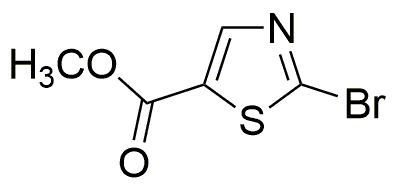Methyl 2-bromothiazole-5-carboxylate is widely utilized in research focused on:
- Pharmaceutical Development: This compound serves as a key intermediate in the synthesis of various pharmaceuticals, particularly in the development of antimicrobial agents. Its unique structure allows for the modification of biological activity, making it valuable in drug discovery.
- Agricultural Chemicals: It is used in the formulation of crop protection products, including fungicides and herbicides. The thiazole ring enhances the efficacy of these agents, providing better protection against pests and diseases in crops.
- Material Science: Methyl 2-bromothiazole-5-carboxylate is employed in the creation of specialty polymers and materials. Its reactivity facilitates the development of advanced materials with tailored properties for specific applications.
- Biochemical Research: Researchers utilize this compound in studies related to enzyme inhibition and receptor binding. Its ability to interact with biological systems makes it a useful tool for understanding complex biochemical pathways.
- Analytical Chemistry: It is also applied in the development of analytical methods for detecting and quantifying thiazole derivatives in various samples, aiding in quality control and regulatory compliance in multiple industries.
General Information
Properties
Safety and Regulations
Applications
Methyl 2-bromothiazole-5-carboxylate is widely utilized in research focused on:
- Pharmaceutical Development: This compound serves as a key intermediate in the synthesis of various pharmaceuticals, particularly in the development of antimicrobial agents. Its unique structure allows for the modification of biological activity, making it valuable in drug discovery.
- Agricultural Chemicals: It is used in the formulation of crop protection products, including fungicides and herbicides. The thiazole ring enhances the efficacy of these agents, providing better protection against pests and diseases in crops.
- Material Science: Methyl 2-bromothiazole-5-carboxylate is employed in the creation of specialty polymers and materials. Its reactivity facilitates the development of advanced materials with tailored properties for specific applications.
- Biochemical Research: Researchers utilize this compound in studies related to enzyme inhibition and receptor binding. Its ability to interact with biological systems makes it a useful tool for understanding complex biochemical pathways.
- Analytical Chemistry: It is also applied in the development of analytical methods for detecting and quantifying thiazole derivatives in various samples, aiding in quality control and regulatory compliance in multiple industries.
Documents
Safety Data Sheets (SDS)
The SDS provides comprehensive safety information on handling, storage, and disposal of the product.
Product Specification (PS)
The PS provides a comprehensive breakdown of the product’s properties, including chemical composition, physical state, purity, and storage requirements. It also details acceptable quality ranges and the product's intended applications.
Certificates of Analysis (COA)
Search for Certificates of Analysis (COA) by entering the products Lot Number. Lot and Batch Numbers can be found on a product’s label following the words ‘Lot’ or ‘Batch’.
*Catalog Number
*Lot Number
Certificates Of Origin (COO)
This COO confirms the country where the product was manufactured, and also details the materials and components used in it and whether it is derived from natural, synthetic, or other specific sources. This certificate may be required for customs, trade, and regulatory compliance.
*Catalog Number
*Lot Number
Safety Data Sheets (SDS)
The SDS provides comprehensive safety information on handling, storage, and disposal of the product.
DownloadProduct Specification (PS)
The PS provides a comprehensive breakdown of the product’s properties, including chemical composition, physical state, purity, and storage requirements. It also details acceptable quality ranges and the product's intended applications.
DownloadCertificates of Analysis (COA)
Search for Certificates of Analysis (COA) by entering the products Lot Number. Lot and Batch Numbers can be found on a product’s label following the words ‘Lot’ or ‘Batch’.
*Catalog Number
*Lot Number
Certificates Of Origin (COO)
This COO confirms the country where the product was manufactured, and also details the materials and components used in it and whether it is derived from natural, synthetic, or other specific sources. This certificate may be required for customs, trade, and regulatory compliance.


